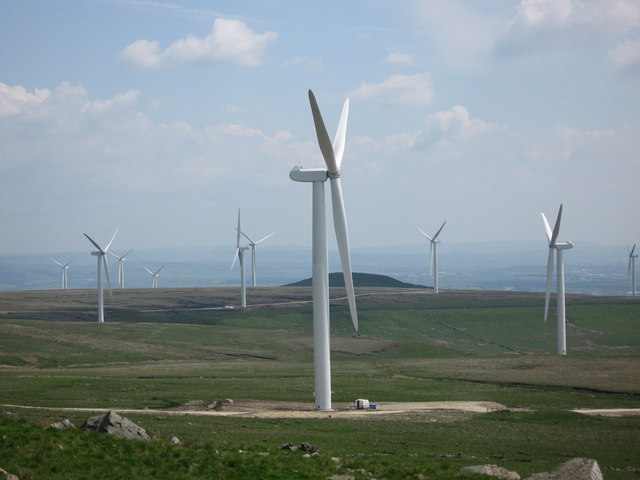Topic 8: Wind energy
 Brief Encounter
Brief Encounter
The wind and us

Windy days – how do they make us feel?
1. Spend time outside on a windy day. Think about:
- What do you hear?
- What do you see?
- Where in your body do you feel it?
- What does it feel like?
- Can you taste it?
- How do you feel emotionally?
- How does your body respond?
- What does it make you want to do?
- What memories does it evoke?
2. Use charcoal, body sculpture or percussion to express and illustrate how the wind makes you think or feel.
3. With a partner, now combine your artworks to create one new work of art.
Multisensory experiences of the wind
Opportunities for Embracing Uncertainty
This activity enables students to attend closely to sensations and how they respond to them. It engages with the topic of wind in ways that extend beyond ‘facts’ and the intellectual. This can tie in with reading an AA Milne story (see below) which presents an additional opportunity for students to think how they might support each other as they express worries: how do we listen attentively to each other; what do we do to respond kindly and supportively, without dismissing feelings of uncertainty or ambivalence? How do we feel or think about other things that exists, but we cannot see, or vice versa (e.g. reflections in a mirror)?
Opportunities for All Students
This activity is appropriate for all students. Students of any age can also enjoy returning to the story from The House at Pooh Corner by A A Milne and EH Shephard (p.132) in which, faced with a strong autumnal wind, Piglet’s ears ‘streamed behind him like banners as he fought his way along’. Piglet worries and says, ‘supposing a tree fell down, Pooh, when we were underneath it?’ ‘Supposing it didn’t’, said Pooh after careful thought. In this example, Pooh’s careful listening connects with and acknowledges Piglet’s fear, felt in another time and place. He does not respond with blind optimism that dismisses Piglet but proffers a different way for Piglet to think.
Opportunities for Creativity
This activity encourages students to use different media to explore their responses to wind. The questions posed in this encounter lend themselves to a wealth of creative thinking and of using all senses to embrace the multitude of aspects that are associated with wind and our world. How does wind happen? Why does it happen? Are there advantages and disadvantages to wind? Why do they have different strengths? How does nature use wind (e.g. to distribute seeds for example)?
Opportunities for Linking to Climate Justice
There are opportunities with this encounter to explore the global aspect of wind, which emphasises how we are all connected. It brings with it seeds, sand, ash and pollutants from other areas; activities that increase carbon in one part of the world create life-threatening weather patterns (e.g. tornadoes; cyclones) in other regions. This might lead to a discussion of our responsibility to others globally. Students might also explore how extreme wind conditions might be experienced, drawing on their own reflections of a windy day. They might share stories of extreme weather told by extended family members. (This links well to the issues raised for young people living India, in Vinita’s film, Topic 1).
 Deliberative Encounter
Deliberative Encounter
Thinking about a wind turbine near me
Imagine that your Local Authority is consulting the community about installing a turbine in your school grounds.
1. What do you picture?
- What is it you imagine?
- How big would it be?
- Was is it made of?
- What sound would it make?
- Where would it be placed?
2. How do you think these groups would respond to the turbine?
- Local farmer
- Headteacher
- Royal Society for the Protection of Birds (RSPB)
- Local resident
- National energy provider
- Local colonies of bats
3. What questions would you want to ask the Local Authority to help you decide whether you are in favour of or against the proposal?
Thinking deeply before coming to a position
Opportunities for Embracing Uncertainty
This activity is designed to make the concept of a wind energy more real for students and it could be incorporated after input (using images/film/visit) on wind turbines as a source of sustainable energy. Scientists have identified wind energy as an important mitigator for climate change (see: https://www.ipcc.ch/report/ar6/wg3/figures/summary-for-policymakers/IPCC_AR6_WGIII_FigureSPM7.png), but there remain public debates about whether and where to place turbines. The activity gives students the opportunity to reflect before coming to their own position. Students might be invited to consider how to overcome resistance to onshore wind turbines (e.g. Do they need to be so big? Could they be miniaturised? Camouflaged? Embedded within household structures or somewhere else? Something else?)
Opportunities for All Students
All students, even the youngest, can consider different positions on wind as a source of energy. Some will engage in more depth than others with the views that different groups might have. Students could also engage in Mantel of the Expert or De Bono’s Hats type activities to investigate the concepts from the perspectives of others.
Opportunities for Creativity
In reflecting on different factors that need to be considered when placing new turbines in the local environment, students are encouraged to consider implications from a number of perspectives, including aesthetics, noise, land versus sea-based options, carbon footprint of the production of different parts of the turbine (i.e. steel tower and plastic blades), and the possibilities of harming or enhancing habitats. Students can be invited to make models of wind turbines and to decorate them with feelings, thoughts and questions. Together, the class turbines can create a wind farm as an exhibition. The audience can be asked to consider:
What is this to me?
- What do I see?
- What does it mean to me? (What do I think or feel?)
- What am I being taught?
What am I to this?
- Where am I in this story?
- What do I know that I could share with the young people or teachers?
- What does the exhibition demand of me as an . . . Parent/carer? Young person? Charity? Citizen?
Opportunities for Linking to Climate Justice
Thinking about wind turbines raises questions about who has the power to decide where they are situated and who might be most immediately impacted. Students might contemplate the example where Greta Thunberg was involved in protesting against the siting of a windfarm (see: https://www.reuters.com/business/environment/thunberg-other-protesters-block-norway-energy-ministry-over-wind-farms-2023-02-27/). It was argued that the farm would disrupt cultural practices of grazing reindeer that have been central to the Sámi indigenous community in Norway.
 Visual Encounter
Visual Encounter
Creating a turbine movement piece
Watch this Uncertainty Movement film, a coastal sequence performed by students.
Whilst watching the film, pay attention to what you notice, think and feel.
[https://youtu.be/0GHhT-wB_Is]
2. In groups, work out how to create a turbine movement similar to that seen in the film.
How you do this will depend on the size of your group.
3. Identify other ‘things’ that would interact with a wind turbine in your local landscape – you will need to decide if your turbine is on land or out at sea.
This might be people, other species (e.g. birds, fish, trees) or other things (e.g. electrical cables, rain, stones, waves). Think about how your chosen thing might interact with the turbine to create sounds, movements, shapes, different uses or shared habitats.
4. Choose one (or more) of these things and create your own group movement for it.
You might want to look at the film again to get some inspiration.
5. Think about whether you might perform, teach or involve others in your movement piece.
This could be people in your school or the wider community.
Embodied engagement with the possibilities of wind
Opportunities for Embracing Uncertainty
This activity fosters an embodied emotional engagement with wind turbines. It requires students to work alongside others in close physical proximity. This encourages trust and communication other than through words. The compositions involve touch, rhythm, co-ordination, control, focus, and a close listening. Uncertainty exists in students’ act of interpretation, how the coordination will work, and that the piece changes each time it is performed.
Opportunities for All Students
This activity can be used with all ages. Some may need more support with creating a movement piece and it may be easier to do this alone rather than as a coordinated group: this could include the use of toys and other props to support their movements.
Opportunities for Creativity
As well as movement, students might also generate accompanying soundscapes. They could also use or create props (such as windchimes) or use varied wind instruments to accompany the piece: some might make their own instruments from reused plastics or natural items such as bamboo and reeds, to integrate into their performance. Equally, they might want to script a message or an interaction that is integral to the piece. The activity offers the opportunity for performance to others and finding ways to involve the audience in engaging with the piece and its themes.
Opportunities for Linking to Climate Justice
There are a myriad of different gods and goddesses of winds (see: https://en.wikipedia.org/wiki/List_of_wind_deities) within different cultures that embody different elements, directionality, intensity and connection to other weather features (e.g. thunder and lightning). Students can be invited to consider why wind features so prominently among different cultural deities. For students who speak other languages and know of different deities, they can be invited to show what they know. Students might integrate the names, sounds, stories of these deities into their performances.
 Beyond the Classroom Encounter
Beyond the Classroom Encounter
Carbon, the world, and us
Richer countries consume a disproportionate amount of energy compared with poorer countries, and in all countries those with more money consume more energy than others. For the foreseeable future, the world cannot produce enough sustainably sourced energy, such as wind power, for all people globally to have the energy to consume items that people expect or desire to have in the UK.
Over one weekend, notice the things that your household (you and others that you live with) use or do that produce carbon. With your household, discuss and agree together:
- 3 things that you feel you could change to use less carbon (e.g. walk to school)
- 3 things that use carbon that you would like to have or to do (e.g. more flights abroad)
- 3 things that you would definitely not change to reduce carbon (e.g. keep your fridge)
You might not all agree. Your discussions will involve listening, negotiating and possibly compromising.
Negotiating carbon reduction
Opportunities for Embracing Uncertainty
Drawing attention to climate justice issues requires students to consider whether and how they might change aspects of their own behaviour. Making such choices is challenging, particularly where it requires negotiation with others who might see things differently.
Opportunities for All Students
Younger students can be supported to think which activities and practices use more or less energy. Some students can use online calculators to work out their carbon footprint: https://www.carbonfootprint.com/calculator.aspx and https://footprint.wwf.org.uk/. They can be encouraged to consider whether anything surprises them, as well as what the figures make them think or feel. Students might have a mix of emotional responses, including guilt, anger or enthusiasm for the possibility to make a difference.
Opportunities for Creativity
Once the students have decided how they might lower their carbon footprint they can be encouraged to think creatively, by addressing deeper questions: Can you commit to three ways in which you will use less energy that produces carbon? How does this feel? Does this challenge the kind of life you wish to live? Are there any benefits beyond using less carbon? Students might create a response to the idea of changing their behaviours or lifestyle. A poem or drawing, for example, could tap into the complexity of their feelings. Or else they might choose different colours (e.g. using paint colour charts) and create a montage to show and speak about the mix of feelings using these colours (they might also draw on the names of the colours given by paint companies).
Opportunities for Linking to Climate Justice
These charts might be useful to use as an initial input on the challenges of climate justice: https://theconversation.com/climate-change-is-a-justice-issue-these-6-charts-show-why-170072. These could be used to provoke a discussion on the responsibilities to others, both within and between communities in different countries across the world. This could lead into further deliberation on the requirement to renumerate countries in the Global South for their loss and damage due to climate change (see: https://unfccc.int/news/cop27-reaches-breakthrough-agreement-on-new-loss-and-damage-fund-for-vulnerable-countries).

